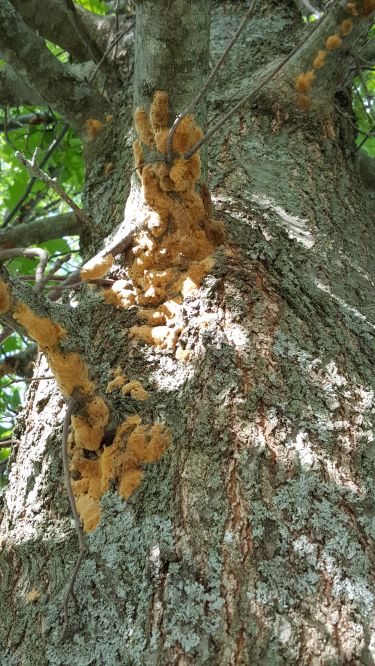Photo: Fall treated oak versus untreated oak during peak defoliation in New England. 2017
Oaks, a diverse family, and one of the stateliest trees in our native and urban forests, are often overlooked because they’ve “always been here”, and most people just expect that they always will.
As endless waves of non-native tree pests have marched across the country devastating native trees; and as climate change has increased tree-stress allowing the devastation by native pests, we frequently hear the same rhetorical rote response. “It’s nature, it is not ours to fix or change”. This is not a sound argument, as there is much we can do, and much of the damage is with man’s influence.
As tree pests enter the country, native trees lack natural defenses against them, so while they only kill weak trees in their native country; here, they kill our otherwise healthy native trees.
 Emerald Ash Borer is one such example. In Asia, they did not wipe out all ash, but here, unprotected ash are being killed by the millions. It is not just the loss of dominant tree species that has us worried. These primary types of tree species are/were dominant throughout the ecosystems in which they live. Our group remembrance includes several tree families that have been nearly wiped out including; Chestnuts, Elms and now ash.
Emerald Ash Borer is one such example. In Asia, they did not wipe out all ash, but here, unprotected ash are being killed by the millions. It is not just the loss of dominant tree species that has us worried. These primary types of tree species are/were dominant throughout the ecosystems in which they live. Our group remembrance includes several tree families that have been nearly wiped out including; Chestnuts, Elms and now ash.
With the loss of these species, animals who depend on them for food and shelter must seek alternatives, and the entire ecosystem may undergo significant change.
Loss of ash in riparian areas affect the temperature of streams making them inhospitable to game fish, including trout. Arguably the largest group of non-coniferous trees remain the oak family. Not only are oaks at risk from primary native and non-native predators, but they are also weakened by drought, heat, and caterpillar defoliation, making them susceptible to secondary invaders like the Two-line Chestnut Borer, which is a relative of the EAB.
Some of the consequential but treatable insect and disease pests attacking oaks throughout the country, include; Invasive shot hole Gypsy moth egg masses on oak, each mass has 500+ eggs borers in the west, two-lined chestnut borer wherever oaks are stressed, Burr Oak Blight in the upper Midwest and plains, Gold spotted oak borer in California, Sudden Oak Death along the west coast, Oak worms, anthracnose, Gypsy Moth and Oak Wilt throughout the center of the country north to south.
The good news when weighing alternatives to protect urban oak species is that environmentally sound solutions are in already here. We don’t need to lose our oaks.
Throughout the northeast, Gypsy moths recently killed millions of otherwise healthy, mature oak trees, because few read about or responded in time to the potential devastation. Populations exploded with the onset of drought. Not only are the results devastating for the environment, but the impact on utilities, as trees decay and fall, will be enormous.
We can’t keep permitting one dominant species after another to falter and die, as if there is always another family of trees to replace it. This is simply not true.
 Many of these tree pests can be controlled with fall (or spring) trunk injections, with some products remaining in the tree until spring pests hatch, others last for multiple years, and yet others are designed to protect trees while we seek to strengthen them after climatic extremes. From effective fertility to products which enhance root development, microbial support, and beyond, if we, Arborists and Horticulturalists, don’t protect our urban forests from the onslaught, who will in our absence?
Many of these tree pests can be controlled with fall (or spring) trunk injections, with some products remaining in the tree until spring pests hatch, others last for multiple years, and yet others are designed to protect trees while we seek to strengthen them after climatic extremes. From effective fertility to products which enhance root development, microbial support, and beyond, if we, Arborists and Horticulturalists, don’t protect our urban forests from the onslaught, who will in our absence?
Photo: Hillside Oaks stripped of foliage
Until next time this Rob Gorden signing off!
Rob Gorden
Arborjet’s Director of Urban Forestry and Business Development
